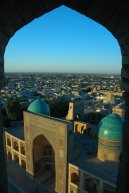| Introduction - Uzbekistan: |
| Location - Uzbekistan: |
| People - Uzbekistan: |
| Government - Uzbekistan: |
| Economy - Uzbekistan: |
Economy overview | Uzbekistan is a dry, landlocked country of which 11% consists of intensely cultivated, irrigated river valleys. More than 60% of its population lives in densely populated rural communities. Uzbekistan is now the worlds second-largest cotton exporter and fifth largest producer; it relies heavily on cotton production as the major source of export earnings. Other major export earners include gold, natural gas, and oil. Following independence in September 1991, the government sought to prop up its Soviet-style command economy with subsidies and tight controls on production and prices. While aware of the need to improve the investment climate, the government still sponsors measures that often increase, not decrease, its control over business decisions. A sharp increase in the inequality of income distribution has hurt the lower ranks of society since independence. In 2003, the government accepted Article VIII obligations under the IMF, providing for full currency convertibility. However, strict currency controls and tightening of borders have lessened the effects of convertibility and have also led to some shortages that have further stifled economic activity. The Central Bank often delays or restricts convertibility, especially for consumer goods. Potential investment by Russia and China in Uzbekistans gas and oil industry may boost growth prospects. In November 2005, Russian President Vladimir PUTIN and Uzbekistan President KARIMOV signed an alliance, which included provisions for economic and business cooperation. Russian businesses have shown increased interest in Uzbekistan, especially in mining, telecom, and oil and gas. In December 2005, the Russians opened a Trade House to support and develop Russian-Uzbek business and economic ties. In 2006, Uzbekistan took steps to rejoin the Collective Security Treaty Organization (CSTO) and the Eurasian Economic Community (EurASEC), both organizations dominated by Russia. Uzbek authorities have accused US and other foreign companies operating in Uzbekistan of violating Uzbek tax laws and have frozen their assets. US firms have not made major investments in Uzbekistan in the last 5 years. |
|
Gdp purchasing power parity | $55.75 billion (2006 est.) |
|
Gdp official exchange rate | $10.83 billion (2006 est.) |
|
Gdp real growth rate | 7.3% (2006 est.) |
|
Gdp per capita ppp | $2,000 (2006 est.) |
|
Gdp composition by sector | agriculture: 31.1%
industry: 25.7%
services: 43.2% (2006 est.) |
|
Labor force | 14.44 million (2006 est.) |
|
Labor force by occupation | agriculture: 44%
industry: 20%
services: 36% (1995) |
|
Unemployment rate | 3% officially by the Ministry of Labor, plus another 20% underemployed (2006) |
|
Population below poverty line | 33% (2004 est.) |
|
Household income or consumption by percentage share | lowest 10%: 3.6%
highest 10%: 22% (2000) |
|
Distribution of family income gini index | 26.8 (2000) |
|
Inflation rate consumer prices | 7.6% officially, but 38% based on analysis of consumer prices (2006) |
|
Budget | revenues: $4.08 billion
expenditures: $4.24 billion; including capital expenditures of $NA (FY07 est.) |
|
Public debt | 29.7% of GDP (2006 est.) |
|
Agriculture products | cotton, vegetables, fruits, grain; livestock |
|
Industries | textiles, food processing, machine building, metallurgy, gold, petroleum, natural gas, chemicals |
|
Industrial production growth rate | 10.8% (2006 est.) |
|
Electricity production | 49 billion kWh (2006 est.) |
|
Electricity consumption | 47 billion kWh (2006 est.) |
|
Electricity exports | 6.8 billion kWh (2006) |
|
Electricity imports | 10.5 billion kWh (2006 est.) |
|
Oil production | 142,000 bbl/day (2004) |
|
Oil consumption | 148,000 bbl/day (2004) |
|
Oil exports | NA bbl/day |
|
Oil imports | NA |
|
Oil proved reserves | 594 million bbl (1 January 2005) |
|
Natural gas production | 62.5 billion cu m (2006 est.) |
|
Natural gas consumption | 48.4 billion cu m (2006 est.) |
|
Natural gas exports | 12.5 billion cu m (2006 est.) |
|
Natural gas imports | NA |
|
Natural gas proved reserves | 1.875 trillion cu m (1 January 2005 est.) |
|
Current account balance | $1.41 billion (2006 est.) |
|
Exports | $5.51 billion f.o.b. (2006 est.) |
|
Exports commodities | cotton, gold, energy products, mineral fertilizers, ferrous and non-ferrous metals, textiles, food products, machinery, automobiles |
|
Exports partners | Russia 23.9%, Poland 11.8%, China 10.5%, Turkey 7.5%, Kazakhstan 6%, Ukraine 4.7%, Bangladesh 4.4% (2006) |
|
Imports | $3.99 billion f.o.b. (2006 est.) |
|
Imports commodities | machinery and equipment, foodstuffs, chemicals, ferrous and non-ferrous metals |
|
Imports partners | Russia 27.8%, South Korea 15.6%, China 10.4%, Kazakhstan 7.3%, Germany 7.1%, Ukraine 4.8%, Turkey 4.5% (2006) |
|
Reserves of foreign exchange and gold | $2.986 billion (2006 est.) |
|
Debt external | $4.713 billion (2006 est.) |
|
Economic aid recipient | $91.6 million from the US (2005) |
|
Currency code | Uzbekistani soum (UZS) |
|
Exchange rates | Uzbekistani soum per US dollar - 1,219.8 (2006), 1,020 (2005), 971.265 (2004), 771.029 (2003), 423.832 (2002) |
|
| Communications - Uzbekistan: |
| Transportation - Uzbekistan: |
| Military - Uzbekistan: |
This page was last updated on 16 September, 2007



